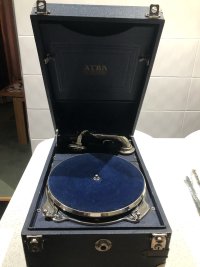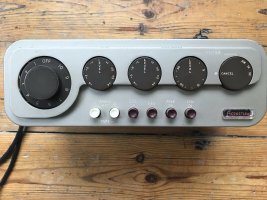Anyone else interested in playing shellac? I have always been interested, and since retirement have actively collected discs. The early stuff, 1901 - 1914, and particularly Russian recordings. And early 20th century recordings of veteran artists, that is those who had major careers in the 19th century.
I have a few entirely mechanical machines on which I could play them, but there are issues of wear, and volumes aren't easily regulated, except by putting a sock in it (it being the horn). The earliest, a 1907 Gramophone Company ("HMV") cabinet model kicks up a terrific racket, even with a soft tone needle, and the latest, a c.1935 Expert open horn is even louder.
From an information retrieval perspective, a modern electrical player has its advantages. And a modern pick up won't wear an irreplaceable disc, the volume is easy to control, and a 32band equalizer is helpful in lessening low- and high- frequency nasties. But unlike the early days of LP, three speed record decks are now very few on the ground, and those with a wide speed variation control even fewer. This latter is a big deal with earlier discs. Few were actually cut at 78 rpm, which only became a standard later. For instance, early Victors commonly play at around 72 rpm; Odeons can whizz round at speeds in the mid to high 80s.
The first part of the reproducing chain is that DJ favourite, a Technics 1200. Fitted with a mod produced by K.A.B. in the USA, it can cope with most speeds, except the fastest Odeons. And because it's a Direct Drive mechanism, with no sprung suspension, it doesn't going wobbling about when asked to turn a very heavy disc at high speed. A more elegant solution than the reading lamp voltage dropper I used to employ with a Garrard 301. The Technics arm is adequate, and most importantly has a standard interchangeable headshell. That's important because early discs call for a variety of stylus sizes, and swapping headshell and cartridge is less fiddly than sliding stylus assemblies in and out of a cartridge. I use Shure M78 bodies with a couple of Expert styli, and Shure's own.
Equalization is the next issue. Or rather, the lack of it. Early discs weren't recorded electrically, and there was no equalization, RIAA or otherwise. Play any 78 through an RIAA circuit, and it will have too much bass and too little top. But most every phono pre-amp comes with RIAA equalization, for free. My solution was to feed the output from the phono stage to a 32-band graphic equalizer, with its sliders set to a mirror image of the RIAA curve. Resultant output is approximately "flat".
The results can surprise. OK, orchestral sound is a wheezing oompah band, and piano too often a tinkling travesty. But the voices of those singers born as long ago as the 1840s can sound amazingly vivid and present.
I have a few entirely mechanical machines on which I could play them, but there are issues of wear, and volumes aren't easily regulated, except by putting a sock in it (it being the horn). The earliest, a 1907 Gramophone Company ("HMV") cabinet model kicks up a terrific racket, even with a soft tone needle, and the latest, a c.1935 Expert open horn is even louder.
From an information retrieval perspective, a modern electrical player has its advantages. And a modern pick up won't wear an irreplaceable disc, the volume is easy to control, and a 32band equalizer is helpful in lessening low- and high- frequency nasties. But unlike the early days of LP, three speed record decks are now very few on the ground, and those with a wide speed variation control even fewer. This latter is a big deal with earlier discs. Few were actually cut at 78 rpm, which only became a standard later. For instance, early Victors commonly play at around 72 rpm; Odeons can whizz round at speeds in the mid to high 80s.
The first part of the reproducing chain is that DJ favourite, a Technics 1200. Fitted with a mod produced by K.A.B. in the USA, it can cope with most speeds, except the fastest Odeons. And because it's a Direct Drive mechanism, with no sprung suspension, it doesn't going wobbling about when asked to turn a very heavy disc at high speed. A more elegant solution than the reading lamp voltage dropper I used to employ with a Garrard 301. The Technics arm is adequate, and most importantly has a standard interchangeable headshell. That's important because early discs call for a variety of stylus sizes, and swapping headshell and cartridge is less fiddly than sliding stylus assemblies in and out of a cartridge. I use Shure M78 bodies with a couple of Expert styli, and Shure's own.
Equalization is the next issue. Or rather, the lack of it. Early discs weren't recorded electrically, and there was no equalization, RIAA or otherwise. Play any 78 through an RIAA circuit, and it will have too much bass and too little top. But most every phono pre-amp comes with RIAA equalization, for free. My solution was to feed the output from the phono stage to a 32-band graphic equalizer, with its sliders set to a mirror image of the RIAA curve. Resultant output is approximately "flat".
The results can surprise. OK, orchestral sound is a wheezing oompah band, and piano too often a tinkling travesty. But the voices of those singers born as long ago as the 1840s can sound amazingly vivid and present.



